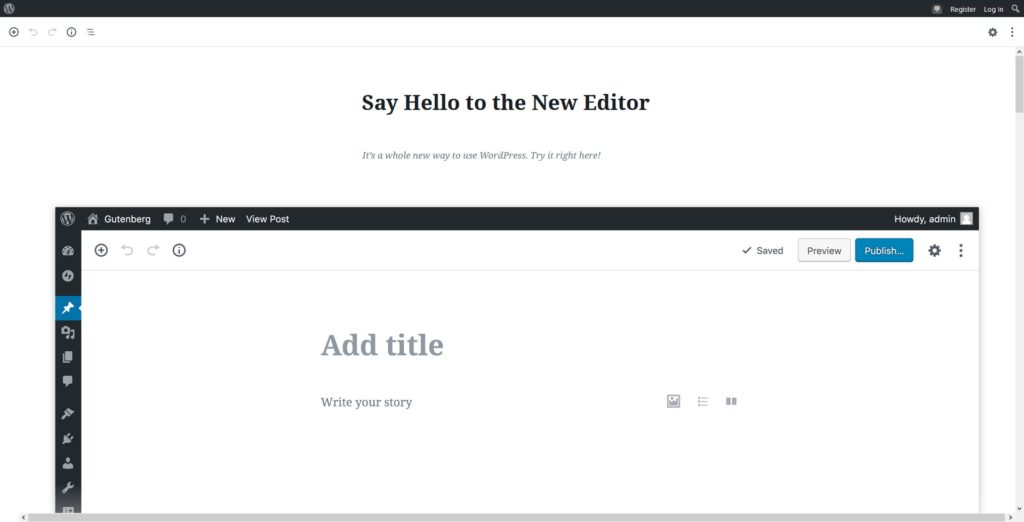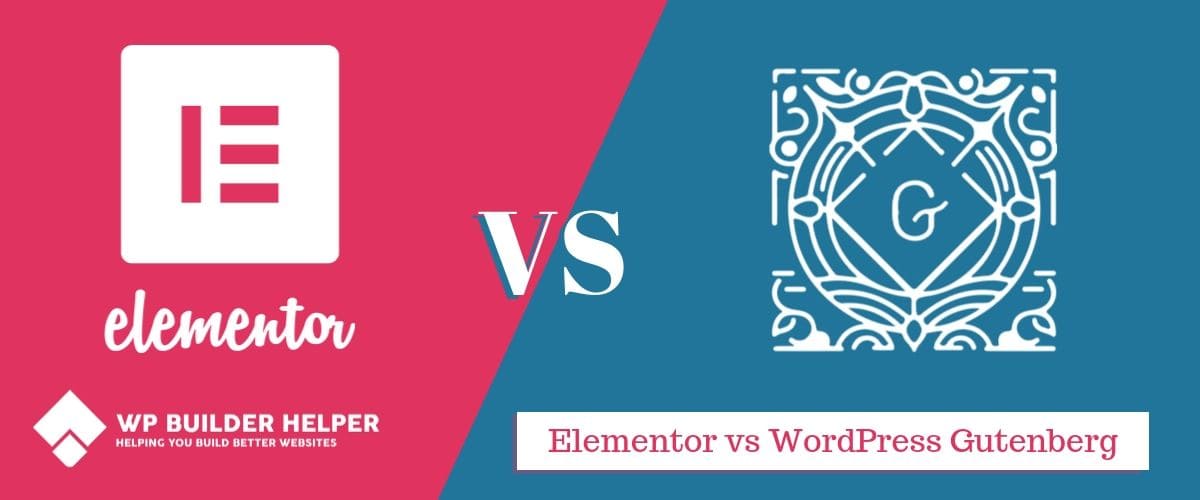When you are first building, your first website or even just websites for clients you might be curious about when you should use something like Gutenberg or when you should use Elementor. In this article we will discuss what the differences are and why pick one over the other.
WordPress Gutenberg vs Elementor which is better? Gutenberg is the default WordPress editor installed in WordPress 5.0 and later, this editor is used to edit pages and posts but does not give you full theme editing. Elementor is a page builder which can allow you to edit both pages and posts and the PRO version gives you full theme editing such as pop-ups, headers, footers and more.
In this article we will explain why use one of these over the other and we will also talk about something that might change years down the road. Read below to learn more about these programs.
Why do I need either of these?

Gutenberg is now pre-installed with WordPress unless you choose not to install it that is your choice, you could use the old either TinyMCE. When Gutenberg first came out, it was not well received by the WordPress community.
In fact, Gutenberg was so terrible we wrote a post on it explaining why you might not want to give it a chance at all. But like all things Gutenberg has gotten much better with time and that’s not to say it’s good but it’s better.
The biggest reasons you would want to use something like Gutenberg or Elementor is because they are more of page builders. TinyMCE was just a text editor something akin to Word from Microsoft office. If you have ever tried to design a website inside of Word, please don’t.
TinyMCE while it was great for its time, Gutenberg and Elementor give much greater flexibility in the ability to control things like columns, images and just the overall experience. This is not to mention that TinyMCE did a terrible job at designing pages where Gutenberg and Elementor are very similar.
Besides this both editors allow some expanded functionality with plugins and themes that allow full theme building which is very useful when someone wants to customize their website beyond just simple text. So now that we discussed why you need one of these two lets look at what their strengths and weaknesses are.
WordPress Gutenberg

Gutenberg is such a fresh addition to WordPress that it’s hard to really hate it although many people do. WordPress has spent considerable resources to make sure that Gutenberg is being developed in a way that is grows WordPress market share even more while giving an average person more flexibility in designing websites.
The revolution is happening because of things like Squarespace and Wix who are putting a hurt on the giants market share by making simple drop and click websites.
Back when WordPress just had TinyMCE there was little to no way that you could tell someone, okay build a “pretty” website with this. It just could not happen and so people developed themes which gave more flexibility in WordPress core.Well themes are great but they cost people money and so that became more of a hindrance than a strength to WordPress.
Enter Gutenberg block builder with a heavy influence similar to that of Elementor. Gutenberg has changed how pages are built by allowing people to simply drag and drop their items on to a page similar to Squarespace and Wix. This new editor gives a more simplified approach to building pages and yes, we can build even pages.
When you combine the fact that WordPress gives this editor a way for free, you release that this is a match made in heaven. Someone new to web design can build some pages and with the right theme (even headers and footers) such as theme would be something like Oceanwp which allow custom headers and footers. Not to mention Gutenberg doesn’t have as much bloat as Elementor when it’s installed in WordPress which is always good for speed.
The biggest downside to Gutenberg is the lack of support from the community which as of right now really does not like Gutenberg. Another thing that puts Gutenberg behind most page builders is a lack of full theme control which Elementor allows with it’s PRO model.
PROS:
- Free no cost involved
- WordPress backed
- Not a much bloat as page builders
CONS:
- Lack of support from the community
- Development is still sketchy
- Lacks full theme building power
Elementor

Anyone who has been around WordPress knows that Elementor is the big daddy of page builders. Elementor competes with some huge companies out there like Elegant themes and Soflyy makers of their own page builders.
Elementor has continued to evolve as a page builder and crush almost every record. The biggest difference between something like Elementor vs Gutenberg is that Gutenberg is a WordPress core component while Elementor is just a plugin.
Still when you look at something like how many installs Elementor has compared to Gutenberg, you can see there is a major difference in the number of users. One of the biggest reasons is that Elementor has an upgrade path which Gutenberg does not have.
When you move forward and upgrade WordPress to PRO you unlock things like pop-ups, 404 pages, headers, footers and even dynamic content. These are things that Gutenberg does not yet have a way of doing outside of its basic offerings. With Elementor PRO you can rely less on a theme which can save you more money since themes are not cheap but Elementors license is fairly low at about $50/per year.
Elementor also is far ahead of Gutenberg when you consider all the advancements in what page builders can do compared to what Gutenberg can do (more on this below). Elementor just has a solid community and backing that you just can’t beat when you are designing websites.
The biggest downside to Elementor is the cost, if you are someone on a budget then you could run into constraints with paying for a license even if it is only $50 a year for a single license. Another big downside is that one of the golden rules of designing websites is that you should never design your pages using a page builder, this forces you to stay paying that builder or until you can find another one.
Another downside is that Elementor adds much more bloat to the WordPress
PROS:
- Full theme building experience with PRO
- Great community and updates
- Much more control over design options
- Doesn’t rely on themes for designs
CONS:
- More expensive
- Not a WordPress core function
- More bloated than Gutenberg
What about using both Gutenberg and Elementor?

You may decide that you want the best of both worlds and if you did, I can’t call you wrong. If you use both Gutenberg and Elementor that can happen since Elementor has support for Gutenberg (it is a WordPress core function after all) and you want the upgrade path of Elementor.
The biggest challenge that you face using this method is the amount of bloat that a website will have but that is a minor issue to an expert. Most experts will recommend that someone use a caching plugin such as WPRocket or Swift Performance, we recommend swift and it better to us.
But when you combine both options, you often find that you use WordPress Gutenberg for building your posts since it is the native editor and you will use Elementor for building your pages and templates. This is the method we use for building WpBuilderHelper.com and it gives the greatest flexibility but also costs more.
Another big drawback is that Gutenberg is constantly being updated and so is Elementor, this can lead to unexpected results. This means that you could have a conflict with Gutenberg and Elementor; however these from what I have discovered are very rare.
The future of Gutenberg
Remember, above when I said Gutenberg relies on themes to design full websites, well this is true but it may not be. WordPress has been experimenting with full website building capabilities with Gutenberg which makes sense.
You see, WordPress has a vested interest in making sure that Gutenberg is helping the end user since they can go to another platform such as Wix or Squarespace. Elementor does not have this stress to make sure that people like WordPress since most of Elementor involves them completely bypassing things like Gutenberg.
This competition is a healthy competition that forces both programs to adapt and change to their environments. After all if WordPress sees that Elementor can build full themes, then Gutenberg will always be second without the ability for it to build its own themes, which creates the next logical step for Gutenberg.
So while Elementor maybe on the top today for full theme building, Gutenberg has tricks up it sleeve which will lead to further innovation by Elementor, otherwise more users may just stick with Gutenberg. It’s a long shoot if you are looking at it from today’s standards but as soon as you think future, things expand.
You also have to consider that Elementor can add its own capabilities but if they slack, then Gutenberg is right behind it.
Related Questions
So which one is better? Judging from the community and just today standards I would give the solid advantage to Elementor. However, that being said Gutenberg has come a long way, and it only appears to be getting better. Still the upgrade path for Elementor unlocks unlimited potential for full website building and you can’t do that with Gutenberg, yet.
What things is Gutenberg missing? Full theme building is one big huge thing that is driving Elementor to beat Gutenberg but it’s not just that. There are plenty of other things that Elementor does well with the options you are given such as things like colors, CSS properties, etc. Gutenberg’s design requires the end user to know some CSS to customize how it looks and that will also need to change if they want to beat Elementor.
But I have no budget can I use both still? Sure! Elementor has a free edition and Gutenberg is free from the start. You won’t be able to full theme building so you will still need a theme but you can use both builders for free.
Conclusions
I really have enjoyed playing with Gutenberg and while it isn’t as nice as something like Elementor, it has improved the design options over something like TinyMCE (the original editor). I think both of these programs have their place in the WordPress websites, you just have to use them correctly.
If you enjoyed this article and you want to learn more about Elementor and Gutenberg, you can visit our article here to see how we reviewed Elementor. Thanks for stopping by.





